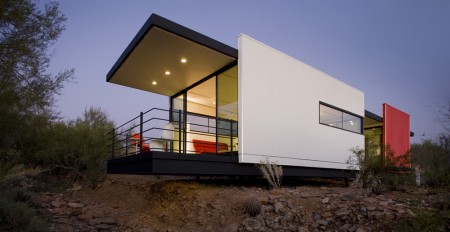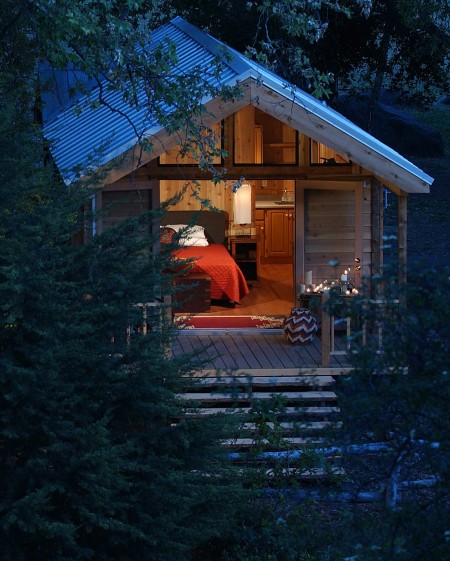Smart, Sustainable, and Do-It-Yourself Cooling Solutions for Your Home
Shireen Shaw wrote this article for the Tiny House Blog. Shireen’s bio is at the bottom of the article.
With cooling costs being so high, especially in light of recent energy crises, it makes sense to start looking for more economical approaches for cooling. However, dwellers of smaller spaces (about 250 sq ft – 925 sq ft) face additional problems when it comes to cooling. Not only do smaller spaces often not include central air conditioners, but even with smaller homes on the larger end of the spectrum are wasting both energy and dollars in over-cooling a small space through central AC usage.
The best option for small spacers is to invest in a portable ac. Portable mobile cooling units provide more specific spot cooling at pennies to a dollar compared to traditional systems. But even with portable cooling units, there are additional clever tips you can utilize to reduce in-home heat. First you should know that there are two types of cooling: passive cooling and active cooling. Active cooling is direct cooling, such as use of a portable, window, or central AC unit, including evaporative coolers. Passive cooling is what we’ll discuss here, which are indirect ways of cooling your home.
Types of Passive Cooling
Window Shading and DIY Awnings – As much as half the heat in your house can come from unshaded windows. The sunny day heat gain from a hundred square feet of eastern or western facing windows is equivalent of running your heater for several hours. Window shading, set up as a canopy outside your house and above the window, blocks the heat from penetrating into your home. There is also the option of window awnings, that resemble umbrella-like structures over a window to provide additional protection against heat. Unlike window shades, awnings are retractable, which allows for additional exterior options.
![]() Sun Screens – Also referred to as solar screening, these shades block up to 90% of sunlight and mount in like vinyl frames (think bug screens). They usually work on a wide variety of windows, particularly ones that would have difficulty with other types of window shades. This is an easy do-it-yourself type of cooling and relatively quick and cheap to complete.
Sun Screens – Also referred to as solar screening, these shades block up to 90% of sunlight and mount in like vinyl frames (think bug screens). They usually work on a wide variety of windows, particularly ones that would have difficulty with other types of window shades. This is an easy do-it-yourself type of cooling and relatively quick and cheap to complete.
Reflective Barriers – Reflective barriers are placed behind solar screens. The advantage of this set up is that it blocks incoming solar radiation while still being aesthetically pleasing.
![]() Trellis – A plant trellis also makes for a great natural way to provide shading and cooling. Bougainvillea and Wisteria are visually appealing and inexpensive plants and naturally grow to cover larger spaces. If you want a spaces covered relatively quickly, then go with Wisteria, which will cover a space within a month to two tops. However, if you want something much faster, then try Morning Glories; but know that these plants are difficult to control because of their growth rate and will easily dominate existing plants and structures if there is no weekly pruning involved.
Trellis – A plant trellis also makes for a great natural way to provide shading and cooling. Bougainvillea and Wisteria are visually appealing and inexpensive plants and naturally grow to cover larger spaces. If you want a spaces covered relatively quickly, then go with Wisteria, which will cover a space within a month to two tops. However, if you want something much faster, then try Morning Glories; but know that these plants are difficult to control because of their growth rate and will easily dominate existing plants and structures if there is no weekly pruning involved.
DIY Rollup Shades – These shades are some of the easiest types around and great for DIY projects. The materials are relatively inexpensive, easy to get, and easy to make. It takes next to no time to make a great patio, porch, or window covering. Some people even use a darker role up shade behind decorative curtains, in order to keep out morning sun or keep rooms cooler during hot summertime weather.
Living Wall System – A living wall system is a panel of plants that when fully grown has the appearance of a wall. They can be created out of flowers, different plants or even hedge like structures. The greenery not only increases oxygen levels, but the wall also adds an aesthetic appeal and additional shading and cooling from the sun’s heat.
![]() Vertical Gardens – Similar to living walls, vertical gardens allows the use of nature to block out unwanted sun and heat. These are great for those who like the living wall idea but don’t want the complete blockage that comes with them. They’re best installed outside a window on the ground or on the balcony.
Vertical Gardens – Similar to living walls, vertical gardens allows the use of nature to block out unwanted sun and heat. These are great for those who like the living wall idea but don’t want the complete blockage that comes with them. They’re best installed outside a window on the ground or on the balcony.
Shading Structures – Some of the smartest shading structure designs were German entries in the 2007 Solar Decathlon. The structures are similar to walls of shutters running along the outer perimeter of the home, create a hallway space around the home. The space is also covered by another panel of shutter like panels. These shading systems can be used on both the eastern and western exposures and are covered with energy-utilizing solar panels.
DIY Cloth Pergolas– DIY pergolas are simple patio covers, and most are easy to make yourself.
![]() Shade Sails – Shade sails, or solar sails, are fabric membranes supported by fixed anchors, and positioned to provide shade. They are laid out and tensioned in such a way as to be very resistant to winds. Shade sails can be used to shade decks, porches, play areas, and windows.
Shade Sails – Shade sails, or solar sails, are fabric membranes supported by fixed anchors, and positioned to provide shade. They are laid out and tensioned in such a way as to be very resistant to winds. Shade sails can be used to shade decks, porches, play areas, and windows.
Cool Metal Roofing – Used for centuries, reflective metal roofing can keep your house cooler and save on cooling bills. Depending on the finish, these types of roofs offer enhanced energy efficiency through solar reflectance and infrared emittance properties. Cool metal roofs are also EPA Energy Star approved.
All these ideas will help limit the amount of heat entering your home, but for the heat already in your home, invest in a portable air conditioner.
Shireen Shah is a writer with http://www.air-conditioner-home.com. Follow her on Twitter @AirConditioners
If you enjoyed this post, subscribe to our feed




I love this blog I have to say!
I think people in a position to create homes on this planet…and lets face it- a massive percentage are at a loss to achieve this…could well do to be inspired to think about some of the ideas presented here. A house can be so much more than a status symbol or a refuge against the world. Security doesn’t just arrive if I keep myself safe….it is a “WE” thing!
Anthems like ‘We are one” and “we are family” make many teary…but really…we have to design more like we are One planet I think!
When talking about heating/cooling tiny houses, I think it’s worth noting a major issue with many of the ‘mobile’ tiny homes featured here regularly- and that is that many heating and cooling systems are wildly innapropriate for certain climates.
A passive solar heating system for example, is going to suck huge amounts of heat from your home in some climates, overheat you in others. Appropriate awning/overhang sizes and angles depend greatly on your latitude. Something that shades your windows in Texas, will leave them totally exposed in Minnesota. Metal roofing is great… unless it’s 120 degrees out and your roof is 190 degrees and sitting 2 feet from your bedroom loft. Porches, dogtrot style homes, and breezeways that keep you cool on a super humid summer day in the south, will leave your house frozen solid in a New York winter.
Most of these technologies are geographically specific, and not at all appropriate for people intending to move their homes.
Eric makes a good point, except for the roof.
Be aware of your enviroment and always plan accordingly. A mobile home means you have to design for the average case instead of the best case, and can mean a world of difference in energy used for climate control. A well designed passive solar home, can meet all of your climate control needs with very very little (if any) energy consumption.
As for the roof, I honestly believe that metal is always the best option, perhaps except living. The much more common asphalt, felt shingles are only that much worst at collecting heat in thee summer. At least the metal is reflective and will allow for a good rain catchment system.
Metal roofs (at least light colored/silver ones) can reflect sunlight, but they also very easily absorb and transfer heat from the surrounding air. If you’re living in a hot climate something like tile is far more appropriate. If you do go with a metal roof, it needs to be designed differently than usual. Making it a ‘floating’ roof is usually the best bet, so that it provides shading weather protection for the house, but isn’t directly connected to it and transferring heat inside.
Can anyone tell me more about the house pictured at the top of this article, please. It looks great and I woudl really like to find out more about it. Thanks
Hi Grahame – that is the The Taliesin Mod.FabTM you can read my post on it here http://tinyhouseblog.com/pre-fab/the-taliesin-modfabtm/ and go to their website from that post…Kent